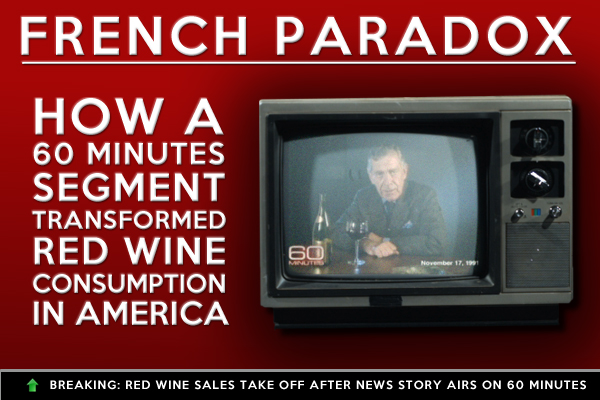By Joseph Temple
One book that should be on every wine aficionado’s reading list is George Taber’s A Toast to Bargain Wines. Chronicling the numerous trends and developments throughout the history of wine, his chapter discussing the 1980s and early 1990s is a truly fascinating read. Known by many as the ‘neo-prohibition’ period in America, the lobbying group Mothers Against Drunk Driving (MADD) was at the apex in terms of political power, having wine (along with other alcoholic drinks) successfully lumped in the same category as marijuana and other “gateway drugs” plaguing society. With sales softening and multinational corporations like Nestle and Coca-Cola selling off their investments in the vineyards of California, the industry was clearly on the ropes.
But on November 17, 1991, United States vintners got a gigantic boost from an unlikely source. For years, representatives from the wine lobby had been trying to educate both politicians and the general public about the supposed health benefits of drinking wine in moderation. All of these efforts however paled in comparison to the free publicity they received from America’s number one television program, with an estimated audience of over twenty million viewers who tuned in that night.
Hosted by Morley Safer, a 60 Minutes segment titled ‘French Paradox’ attempted to solve the mystery regarding French and American diets – and the odd results these contrasting diets had on the health of each nation. The former, which consumed such rich delicacies as foie gras, duck, black pudding, and forty pounds of cheese annually per person, remarkably resulted in less cases of heart disease than the latter. And yet, despite the fact that Americans exercised more regularly than their French counterparts, how could the average Parisian be in better health than the average New Yorker?
The answer to this paradox: red wine.
The segment boasted that by drinking at least one glass a day, the risk of heart attacks and blood clots would be greatly reduced. At least, that was the conclusion viewers were left with on that particular Sunday night. And on Monday morning, a tidal wave of consumer interest in red wine was rippling through the United States.
Discussing the segment’s impact, Taber writes, “People in the California wine business still tell of how Americans went rushing out to buy bottles of red wine that Sunday night. The traditional toast “To your health” suddenly had a new meaning. Red wine sales soared.” Despite being in a short, but sharp recession that year, bottles flew off the shelves as baby boomers were entering their prime earning potential. The result: the number of California wineries shot up from 807 in 1990 to 1,950 a decade later as “eating” now became “dining” and ordering “a glass of white wine” at a restaurant was replaced by ordering “a glass of chardonnay.”
Almost twenty-three years after the show first aired, the wine industry is still sending thank you cards to CBS!
You can watch a four minute clip from the segment by clicking here.
